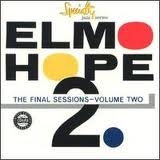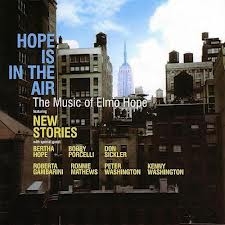Roll On – Elmo Hope
The constantly flowing melody of Roll On leaves little space for a horn player to breathe. It's well worth the challenge, though; in addition to recordings in two different keys, we have Minus You tracks that any instrumentalist can play along with; even rhythm section players can replace their counterparts on the recording.
- Recording: Elmo Hope - The Final Sessions, Volume 2
- Recorded on: May 9, 1966
- Label: Specialty (SP 2179)
- Concert Key: G
- Vocal Range: , to
- Style: Swing (medium)
- Piano - Elmo Hope
- Bass - John Ore
- Drums - Clifford Jarvis
- Description
- Historical Notes
- Solos
- Piano Corner
- Bass Corner
- Drum Corner
- Guitar Corner
- Inside & Beyond
- Minus You
"I love this composition's unusual 25-measure ABA format, starting with an eight-measure A section. B has seven measures which quickly returns to A, which is then extended to ten measures. The solo form is the same.
"Elmo's original G version has a delightful solo piano introduction (listen to the audio excerpt above) which is also cued in all lead sheets. Elmo's original key lead sheet also preserves Elmo's almost-Latin piano comp to the B section."
For more details about Elmo Hope's recordings, check out the Elmo Hope Discography on Noal Cohen's Jazz History website.
Related Songs
Email Send Roll On to a friend
- Recording: New Stories - Hope Is In The Air
- Recorded on: April 28, 1998
- Label: Origin (82434)
- Concert Key: C
- Vocal Range: , to
- Style: Swing (medium)
- Alto Sax - Bobby Porcelli
- Piano - Marc Seales
- Bass - Doug Miller
- Drums - John Bishop
Video
- Description
- Historical Notes
- Solos
- Piano Corner
- Bass Corner
- Drum Corner
- Guitar Corner
- Inside & Beyond
- Minus You
"The C concert lead sheets from the New Stories recording show a different rhythmic approach to the B section, as opposed to Elmo's recording. Careful examination of both lead sheets will reveal other articulation differences as well. Also notice that this version is considerably slower than Elmo's.
"Everyone should enjoy playing this composition at whatever tempo they choose. It's great fun."
Alto saxophonist Bobby Porcelli has been in the Second Floor Music family for many years. Don Sickler and Bobby were first brought together by pianist Rodgers Grant, composer of Morning Star, made famous on the CTI recording of Hubert Laws. Rodgers and Bobby played together in the Mongo Santamaria band. In the 1970s Don and Rodgers both played in hotel bands in the New York Catskills, where all three became friends. Although much of Bobby's career has been spent playing in Latin bands, he has a extraordinary talent for jazz, as you can hear in this excerpt.
CLIP The format of the original track is:
-- melody
-- piano solo [2 choruses]
-- alto sax solo [2 choruses]
-- bass solo [1 chorus]
-- out melody
There are two different Minus Melody tracks, a practice edition with the same format and a shorter performance edition. In the practice edition, the soloist has the opportunity to play accompanied by bass and drums only. For more information about these two minus melody editions, check out our "Gigi Gryce Project" songs with a similar format such as Salute to Birdland.
MP3 minus melody
-- count off sets up the melody
-- play the melody
practice edition: solo 4 choruses
-- 2 choruses with bass and drums
-- 2 choruses with full rhythm section
-- play the out melody
also available performance edition: solo 2 choruses with full rhythm section
mp3 minus piano (use the C treble clef lead sheet)
-- count off sets up the melody
-- comp for the melody
-- solo 2 choruses
-- comp for the alto sax solo [2 choruses]
-- comp for the bass solo [1 chorus]
-- comp for the out melody
mp3 minus bass (use the C treble or C bass clef lead sheet)
-- count off sets up the melody
-- 2-feel for the melody
-- walk for the piano and alto sax solos [2 choruses each]
-- solo 1 chorus
-- 2-feel for the out melody
mp3 minus drums (use the C treble clef lead sheet)
On this recording, drummer John Bishop uses brushes for the melody and the first chorus of the piano solo. He switches to sticks at the second chorus of the piano solo, going back to brushes for the bass solo and out melody. Drummers are welcome to use sticks or brushes at different times with this track.
-- count off sets up the melody
-- comp for the melody
-- comp for the piano solo [2 choruses], alto sax solo [2], and bass solo [1]
-- comp for the out melody
mp3 bass and drums only Pianists or other chordal instrumentalists can use this as a Minus Melody track. A melody instrumentalist can also play with this track for a pianoless trio setting. There are performance and practice editions as in the quartet Minus Melody track.
-- count off sets up the melody
-- play the melody
practice edition: solo 4 choruses
performance edition: solo 2 choruses
-- play the out melody
Related Songs
Email Send Roll On to a friend

Elmo Hope
June 27, 1923 – May 19, 1967
An imaginative pianist who valued subtlety over virtuosity in the landscape of bebop, Elmo Hope never achieved the fame that his close friends did, perhaps because he so rejected stylistic norms of the time. Elmo was a classically trained pianist with technique rivaling that of his childhood friend Bud Powell and a composer of music whose inventiveness and complexity approaches that of Thelonious Monk. In fact, Elmo, Thelonious and Bud used to hang out so much together in the late 1940s they became known as "The Three Musketeers." Powell, in Francis Paudras' book "Dance of the Infidels" is quoted as saying, "You gotta hear Elmo. He's fabulous. His stuff is very hard. He does some things that even I have trouble playing." Read more...




